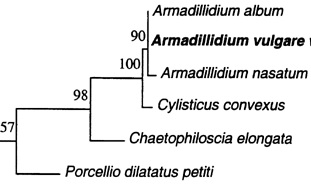Classifying the Roly Poly bug

Domain: Eukarya
Kingdom: Animalia
Phylum: Arthropoda
Class: Malacostraka
Order: Isopoda
Family: Armadillidae
Genus: Armadillidium
Species: Armadillidium vulgare
Domain: Eukarya
The domain Eukarya evolved from the first prokaryotic organisms more
than 1.7 billion years ago. Organisms under the domain Eukarya
have a true nucleus and membrane-bound organelles.
Kingdom: Animalia
Animalia is an extremely diverse kingdom containing more than 1.5
million different species of animal. Armadillidium vulgare fall
under the kingdom Animalia because they are not autotrophs and
instead rely on other organisms as a food source (Encyclopedia
2013).
Phylum: Arthropoda
The arthropods are characterized by the bilateral symmetry of their
bodies, segmented bodies with jointed appendages and a chitinous
exoskeleton. In order to grow, all arthropods undergo ecdysis, or
molting, in which they shed their exoskeleton in order to have a
new, larger one. A.vulgare is an arthropod because it fulfills all
of these characteristics, including ecdysis as shown below.
Class: Malacostraka
Armadillidium vulgare follow the general body plan of Malacostraka
in that their bodies have three parts to them: a head (cephalon),
thorax (pereon) and abdomen (pleon). Inside their bodies they have
a two chambered stomach and appendages on their abdomens called
pleopods that are used for swimming, brooding eggs and catching
food. They have a centralized nervous system with a brain and
ventral nerve cord. A. vulgare fits into this class because it
possesses all of these features (Discover Life in America 2010).
Order: Isopoda
Isopods have two sets of antennae and compound, sessile eyes
(meaning they are not on the end of appendages, such as a crayfish’s
eyes are). They undergo ecdysis (molting) in two phases and have
four sets of jaws (Tree of Life 1997). The isopods use their
pleopods (appendages on the abdomen) for swimming, brooding eggs,
catching food and, specifically, as gills for breathing (Discover
Life in America 2010). A. vulgare display all of these
characteristics.
Family: Armadilliidae
Most within the family Armadillidiidae are characterized by an
hour-glass shaped telson. A telson is the last segment in the
abdomen of a crustacean (the subphylum of A.vulgare is Crustacea).
A. vulgare also falls under this family because it has pigmentation
patterns throughout its thorax, or the part of the body between the
head and the abdomen (British myriapod n.d).
Genus: Armadillidium
The organisms within the genus Armadillidium lack a waxy cuticle
layer to retain moisture within their bodies; this is the main
reason why A.vulgare is nocturnal. Those within Armadillidium have
seven pairs of legs, as opposed to those in the class Insecta, which
only have three pairs. Additionally, Armadillidium organisms are
loosely classified under a size of approximately 15mm (Biotic
Inventory 2010).
Species: Armadillidium vulgare
The scientific name Armadillidium
vulgare translated from Latin to English means common woodlice.
The above phylogeny is a representation of different phyla within the major clade Opisthokonta based on morphological traits. Armadillidium vulgare falls under the phylum Arthropoda due to its bilateral symmetry, chitenous exoskeleton and segmented body among other relative traits.
This particular phylogeny is based on strains of Wolbachia in specific species of isopods (for explained relationship with A.vulgare, visit the Interactions page). Wolbachia is an endosymbiotic bacteria that has mostly parasitic interactions with the isopods in which it lives. In A.vulgare specifically, Wolbachia suppresses important aspects of its immune system. This phylogeny was determined through PCR-based studies of Wolbachia hosts (Cordaux 2004).



